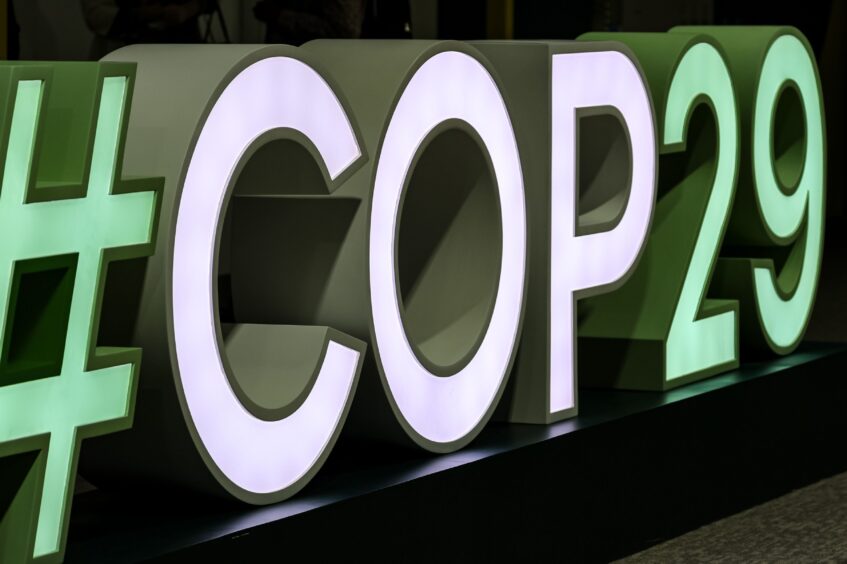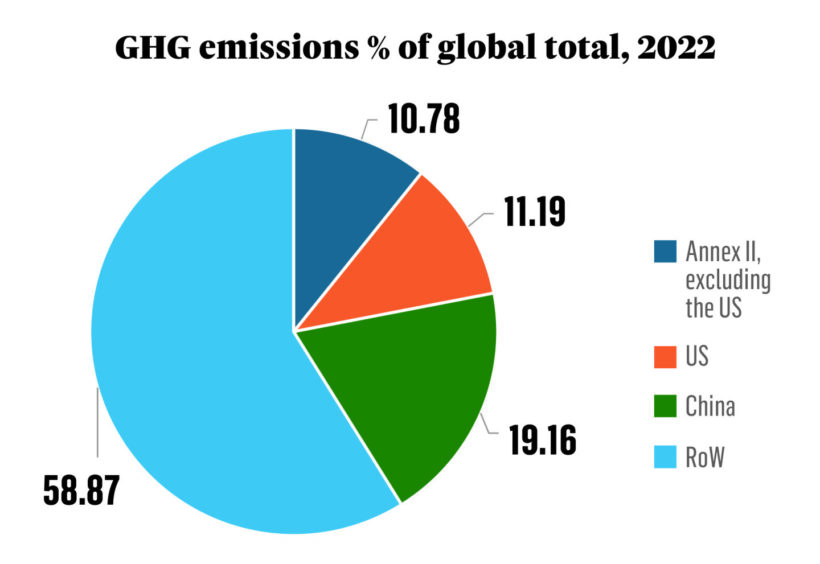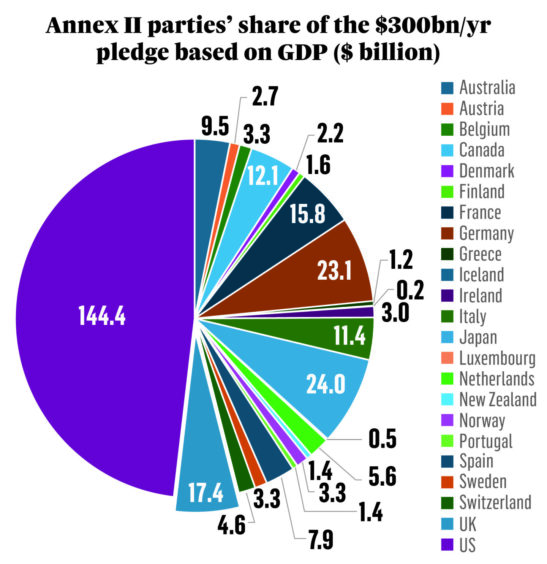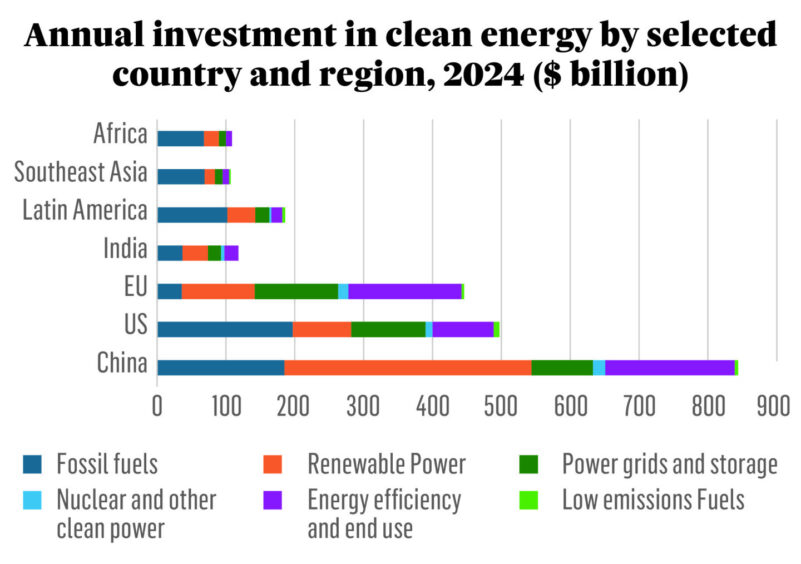 © Shutterstock Feed
© Shutterstock Feed COP29’s headline agreement, reached in extra time in Azerbaijan’s capital Baku on 24 November, was for developed countries to provide at least $300 billion in climate finance a year by 2035. This builds on an earlier deal, ending in 2025, to provide $100 billion/year by 2020, which wasn’t honoured until 2022.
In this context, “developed countries” means Annex II parties under the UN Framework Convention on Climate Change. The list is made up of 23 countries and the European Community – essentially, western Europe, including the UK, Australia, Canada, Japan, New Zealand and the US.
These countries are on the hook owing to their historic use of fossil fuels, which account for the majority of the cumulative greenhouse gas (GHG) emissions causing global warming.
No agreement was reached on exactly which country would pay what and when. Moreover, looming over proceedings was the bulky shadow of US president-elect Donald Trump, who has promised to once again remove the United States from the Paris Agreement on Climate Change.
There thus appears little likelihood of the US contributing much in the next four years. Given also the lack of penalties for non-compliance, the dearth of enthusiasm for the missed 2020 target, and long lead time of 2035, the effort to raise at least $300 billion/year by 2035 is almost certain to get off to a glacial start.
Meanwhile, other countries which could contribute took a step back when the call for volunteers was made, leaving the Annex II parties exposed.
China is the world’s largest emitter of GHGs, but bears little of the historical responsibility, owing to its late economic development. As it is not an Annex II party, it does not have to contribute. Similarly, the Gulf oil states may not be responsible for end users’ emissions, but they have benefitted enormously in financial terms from the global use of fossil fuels – even if they are stuck with economies dependent on oil and gas.
Like China, they are not required to contribute, and, from their own perspective, doing so would only shorten the closing window of opportunity left to diversify away from fossil fuels. So, it was down to the Annex II parties alone, feet dragging across the assembly floor, to make the promises.
Is it enough?
$300 billion a year sounds like a hefty sum, but unflattering comparisons abound. It is small change when contrasted with spending on tanks and bombs, the continued outlay on the fossil fuels which have caused the problem in the first place, or, more importantly, estimates of what is required to keep the Paris Agreement alive and the global rise in temperatures to 1.5°C above pre-industrial levels.
According to the third report of the Independent High-Level Expert Group on Climate Finance, Raising ambition and accelerating delivery of climate finance, Emerging Markets and Developing Economies (EMDEs), excluding China, will require $2.3-2.5 trillion/year by 2030, of which $1 trillion needs to come from external financing.
In other words, the Baku deal is $700 billion/year short and five years too late, even if it arrives on time, in full.
Is it affordable?
If the sum were split proportionately between the Annex II parties on the basis of GDP (2022, nominal), the importance of the US’ even temporary absence becomes clear, as it would need to find 48% of the cash. The UK’s share would be 5.8% or £13.9 billion/year at today’s exchange rates.
In the 2022/23 financial year, the UK government took in £1.1 trillion, but managed to spend a bit more to reach a deficit of £120 billion. At just 1.26% of government income, or 1.13% of expenditure, £13.9 billion is manageable, especially taking a decade’s inflation into account.
It is, in fact, only $1 billion more than current overseas aid spending (known as Official Development Assistance). It would be less, if the UK kept its commitment to the UN made in 2013 to spend 0.7% of gross national income on aid.
But – developing countries beware – that’s the way spending pledges often go.
As an 11.5% increase on the current deficit, £13.9 billion does not look so financially or politically palatable. In the round, the UK can afford it, but as with any additional spending item, it means more debt or less money for the NHS, schools, increased border controls, nuclear deterrents or supporting Ukraine fight off an invasive Russia, depending on your preference.
It’s also worth remembering that the advanced economies have their own bill for the energy transition, which the export group of economists puts at $2.7-2.8 trillion/year collectively by 2030.
How the national pot gets divided is a matter of political priorities and issues perceived to be more immediate tend to dominate, reflecting the short term of the electoral cycle. High levels of foreign aid are also easy fodder for parties which believe charity starts at home.
This is unfortunate because climate change is an immediate issue.
To date, the energy transition has been extremely uneven. According to the International Energy Agency (IEA), EMDEs, excluding China, account for only about 15% of global clean energy spending. This, the IEA says, is “far below the amounts required to ensure full access to modern energy and to meet rising energy demand in a sustainable way.”
And, while they may bear historical responsibility, the Annex II parties today account for only about 21% of global GHG emissions. Climate change cannot be controlled by their internal actions alone, even if they were sufficient. Many countries lack the finance, institutions and technology to fundamentally change their energy systems and, if enough fail, then climate change mitigation fails globally.
What about the opportunities?
The parsimony of the developed nations seems to forget that paying up now has long been seen as the cheap option. Inaction will result in higher costs down the line as climate change takes hold – an argument well-articulated as far back as 2006 in the Stern Review. “The benefits of strong and early action far outweigh the economic costs of not acting,” it advised.
But the energy transition’s possibilities have been sold as more than that. Technologically advanced countries (i.e. the Annex II parties) can sell climate change solutions to the less advanced world. Providing funds to address climate change thus creates markets from which the advanced economies can benefit, very similar to development aid which comes in the form of export guarantees allowing less creditworthy countries to buy the goods of the generous donor country.
However, as Chinese electric vehicles flood the European market and Trump promises tariffs on just about everyone, it has become apparent that China has stolen a march on the world.
Leveraging the manufacturing dominance gifted the country by globalisation, combined with long-standing and well-planned state policies to leapfrog developed countries technologically, China has emerged as the dominate producer of solar panels, permanent magnets, lithium-ion batteries, electric vehicles, wind turbines and all of the intermediate products that go in between.
The leaders of the developed nations, in contrast, appear to have been asleep at the wheel, replete with the disinflationary fruits of globalisation. As a result, China stands to benefit massively from the transfer of funds from developed nations to the developing world in aid of climate change adaptation and mitigation – confident in the knowledge that Chinese goods represent the least cost pathway.
For the developed countries it is a bitter pill to swallow, but the tardy deadline of 2035 at least provides time to invigorate belated reindustrialisation policies and address myriad economic supply chain dependencies on China.
The problem is that a decade of trade protectionism will cause a damaging, possibly fatal, delay and, of course, it is not exactly a recipe for fostering the international solidarity so sorely lacking at COP29.
Ross McCracken is a freelance energy analyst with more than 25 years experience, ranging from oil price assessment with S&P Global to coverage of the LNG market and the emergence of disruptive energy transition technologies.



